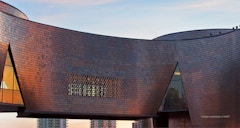
Simulation vs. reality: Insight and inspiration
Dr. Helen Sanders adds context to the Simulation vs. Reality dialogue.

Dr. Helen Sanders adds context to the Simulation vs. Reality dialogue.

The Simulation vs. Reality Forum proved to be the most popular yet hosted by FTI, in person or virtual, emphasizing the importance and sensitivity of this topic in our professional work and its impact on the built environment.

The piezoelectric facade as a self-sustained technology can generate a considerable amount of energy by converting swaying motions (actuated by the

Ever-increasing performance requirements in the latest version of the energy codes are compelling project teams to consider the thermal performance of the building envelope more rigorously than ever before.

Until recently, Google has occupied buildings that were designed for others and modified the interiors to suit its needs. Many of the improvements

Analyzing the energy performance of complex building envelopes, determining the need for sun protection, and assessing the effectiveness of shading


This article discusses design, prototype development and a simulation study of novel types of facade systems, which integrate thermoelectric (TE)

Heat transfer through building facades can occur by any combinations of conduction, convection, and/or radiation. Conductive heat transfer depends on

Over the last two decades, in what has been coined “The Digital Turn”, the introduction of parametric design software has afforded increased

The global increase in atmospheric temperature rise combined with the rapid growth of previously underdeveloped climate zones presents a growing need

The gap between simulated and actual energy performance has hobbled progress towards important carbon reduction goals in buildings and urban habitat. This summit advocates the need for improved energy modeling and the development of best practices, with emphasis on the building façade.
In recent years, the desire for increased performance, transparency and visual flatness of glazing elements in curtain walls has generated renewed

Solar shading devices are required to find a trade-off between conflicting requirements: Protection from excessive solar gains and glare, daylight


Thermal bridging through building façades have been overlooked by designers and building energy codes and standards in the past, which has led to

